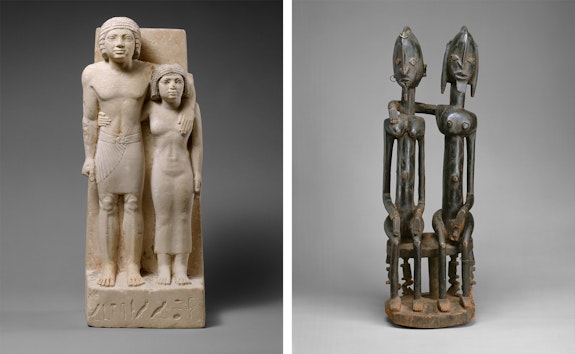ArtSeen
The African Origin of Civilization

On View
Metropolitan Museum Of ArtDecember 21, 2021–ongoing
New York
When you go up the stairs through the main entrance into the Metropolitan Museum of Art, if you turn to the right you immediately enter the Egyptian galleries. And if you head to the left and walk through the Greek galleries, you get to the Michael C. Rockefeller Wing, where the Sub-Saharan Adrian art is displayed. But since Egypt is in Africa, it’s natural to wonder why the displays of African art are divided this way. The answer involves the history of the museum. From the very start, the Met devoted a great deal of attention to Egyptian art. But only recently has the museum also collected what was pejoratively called “primitive” Sub-Saharan art. The announced aim of The African Origin of Civilization is to rethink and undo this false distinction.
The Met’s Sub-Saharan African Art galleries are currently closed for renovation, so the museum has taken twenty-one works from these diverse African cultures, and displayed them mostly alongside works from the Egyptian collection, but also upstairs among Greek works and in the European painting galleries. While the Met’s press release concedes that “there was no contact between their creators,” it proposes that “the works share deep and underrecognized histories.”
Illustrating the claim of Cheikh Anta Diop’s The African Origin of Civilization: Myth or Reality that the ancient Egyptians were Black, and that their depicted figures are therefore Black people, this exhibition thus makes a political statement, ostensibly restoring Sub-Saharan African art to its true place as the origin point of art history. To name a few of the twenty-one pairings: an Egyptian sculpture, The King’s Acquaintances Memi and Sabu (ca. 2575-2465 BC) is set alongside Seated Couple (18th–early-19th century) by a Dogon artist from Mali; The Statue of the Official Merti (ca. 2381–2323 B.C.), Egyptian, is set alongside Linguist Staff: Ceremonial Stool, Chain, and Swords Motif (ȯkyeame poma) (ca. 1930) by an Asante artist of Southern Ghana; and The Goddess Isis and her Son Horus (332–30 BC) is juxtaposed with Tyekpa Maternity Figure (19th–20th century) by a Senufo artist from Côte d’Ivoire. “This exhibition … reveal[s] unexpected parallels and contrasts,” so the wall text says. Indeed, unexpected visual juxtapositions can be suggestive. One might, for example, learn about contrasting aesthetic worldviews by juxtaposing Chinese and European landscapes taken from a period before there was sustained cultural contact between those cultures. But the wall labels here don’t develop any such comparisons for the Sub-Saharan art. What you see, rather, is simply how different the works really are.
Diop’s basic thesis is that for racist reasons it has generally been denied that the ancient Egyptians were Black. It’s no accident that he was writing in the 1950s and 1960s, a time when independence for the former African colonies was a live issue. “The Black man,” he writes, “must become able to restore the continuity of his national historic past, to draw from it the moral advantage needed to reconquer his place in the modern world.”1 And what follows from this logic, he argues, is that the ancient Egyptian art, including some works in the Met included in his illustrations, show Black people because they were made by Black artists. But only a few of the Egyptian rulers are known to be Black. And surely it is visually obvious that these juxtapositions of ancient Egyptian sculptures with relatively recent, very different looking Sub-Saharan works are problematic evidence about the race of these Egyptians. Suppose, for the purpose of argument, that the ancient Egyptians had all been Black. How then might we understand visual parallels between works that are thousands of years old and African sculptures made in the past couple of centuries? As anyone can see by looking, the would-be parallels presented in this show are pseudo-morphisms, for the works set side by side look very different. There really are no deep histories to be shared here.
But that conclusion is surely unsurprising: How could these works look similar, when the religious ideals, entire cultural contexts, and uses of the art are so very different? What’s depressing, then, is that instead of expanding the scholarship, these great African sculptures of the nineteenth and twentieth century are used to sustain an implausible argument. They are brilliantly original and deserving of close attention, but not for what they tell us about art in Egypt.

